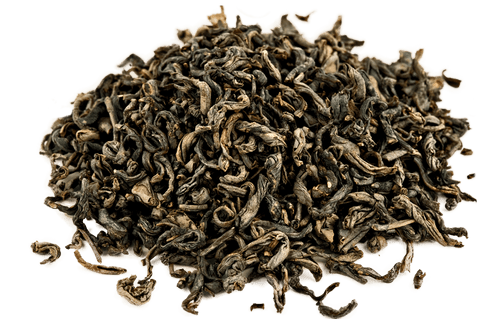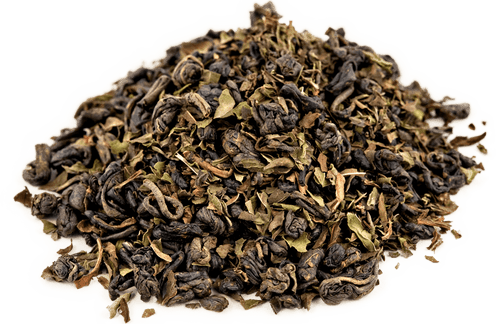Organic Gunpowder Green Tea

The tender leaves of this Fair Trade Certified organic tea from China are steamed and then tightly rolled in a time honored process. When infused, the tightly-rolled pellets yield a medium-bodied, golden infusion with a nutty vegetal flavor. Heat generated during the rolling process lends this tea a hint of smoke.
Legend has it that the name of this organic green tea is owed to a young English clerk who likened the small green pellets to gunpowder. Hot water causes them to open up like flowers and sink slowly to the bottom in graceful patterns.
Note: Gunpowder is denser than other teas, so we recommend only one or two teaspoons for a full teapot, or a scant teaspoon for one cup of organic tea.
Ingredients: organic and Fair Trade Certified Chinese green tea
Origin: Dazhangshan Tea Gardens, Jiangxi Province, China

Jiangxi Province, located in eastern China, is surrounded by mountains on three sides and sits comfortably in a subtropical climate, making it an excellent place for growing tea. Situated in Wuyuan county, the Da Zhang Shan Tea Garden maintains the region’s 1200-year reputation as the “golden triangle” of exceptional tea production. Certified organic in 1997, Da Zhang Shan was the first producer organization in China to gain Fair Trade certification in 2001. With over 5,400 member households, the Da Zhang Shan Tea Association has used their premiums to renovate 3 factories, establish a microcredit program, and build a school, among many other initiatives.
Steeping Instructions
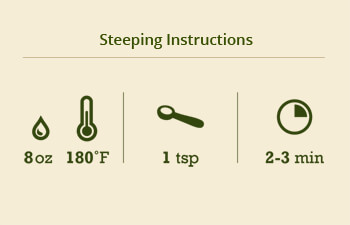
At Arbor Teas, we believe tea should be brewed to suit your personal taste. We’re happy to make recommendations to get you started, but don’t hesitate to experiment! When brewing your tea, your main considerations are tea quantity, water temperature, and steeping time. We recommend green and white teas to be steeped for 2 to 3 minutes in water heated to not-quite-boiling, just as bubbles begin to form on the bottom of the pan (approximately 170 to 180 degrees F). For the best flavor, use fresh water whenever possible. Try not to steep your tea longer than necessary, as you’ll extract undesirable bitterness from the leaves. If you want a stronger brew, don’t steep longer, just use more tea. And don’t forget to re-steep your tea leaves to get the most out of your leaf!
Looking for more info? Check out our How-To Guides and Eco-Brewing Tips!
Staff Perspectives
 Lea
Lea
"This tea will wake you up with a bang!"
 Sarah
Sarah
"This a strong lightly smoky tea with a lot of oomph!"
 Aubrey
Aubrey
"This is our original Gunpowder Green Tea and is a best seller!"
Health Benefits
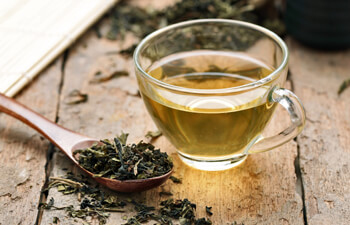
Like all true tea, green tea offers many potential health benefits. Research has found that tea (Camellia sinensis) can have many positive effects on human health, including improved cardiovascular function, cancer risk reduction, improved immune function, improved oral health, and help with weight management. Tea is also full of polyphenols, which are a class of antioxidant that help your body maintain homeostasis and balance your stress levels.
Green tea specifically is known for its array of health benefits, which have been supported by a growing number of studies. Green tea research has demonstrated that it may be an effective anticancer agent for breast cancer, lung cancer, kidney cancer and prostate cancer, among others. Studies have shown a link between green tea and weight loss, and the ability to modulate energy metabolism, aid in body fat regulation, and possibly promote preferential loss in abdominal fat. Research has also shown that green tea may increase performance for short term memory tasks, as well as being increasing potency of antibiotics. Other peer-reviewed studies link green tea to healthy skin, help with lowering cholesterol, and regulating diabetes. It’s important to keep in mind that many of these studies monitor subjects who drink several cups of green tea per day.
For more information about the health benefits of green tea, and for direct sources of the above information, check out our Tea Health Benefits page!
Please note: the information above is for educational purposes only and has not been evaluated by the Food and Drug Administration. This information is not intended to diagnose, treat, cure, or prevent any disease.
Gunpowder
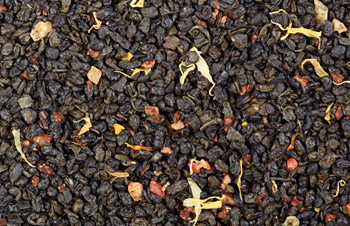
Gunpowder teas are green teas native to the Zhejiang Province of China, and have been around since the Tang dynasty (618-907 CE). Though Zhejiang has historically been the primary source of gunpowder teas, a number of other provinces now contribute to the production of this style, in addition to locales beyond China’s borders. Evidence of British interest in gunpowder teas can be found as early as 1771, in “Osbeck’s Voyage to China and the East Indies,” by Johann Forster. He describes a type of tea “rolled up like peas” and in 1795, the British ambassador to China comments on “The shrub which bears what is called the Imperial and Gunpowder teas.” Gunpowder tea leaves are rolled into little balls to help protect them from physical damage during transport and storage, and help preserve the flavor of the tea. Traditionally, the individual leaves were rolled by hand, and in the highest quality varieties this is still the case. However, the majority of gunpowder teas are rolled by machines these days. In many cases, the friction of the machine-rolling process will heat up the leaves, altering the flavor and imparting a roasted quality.
For even more information about this and other traditions, visit our Tea Traditions Page!








